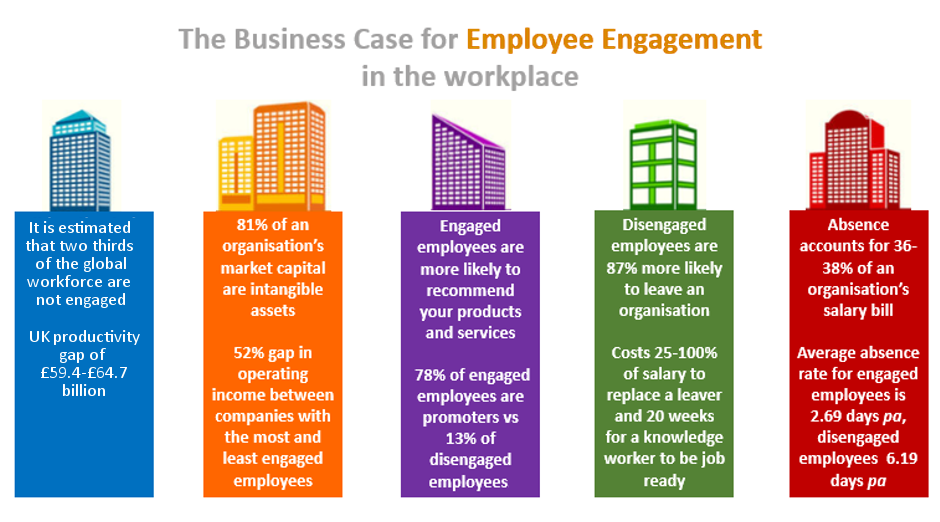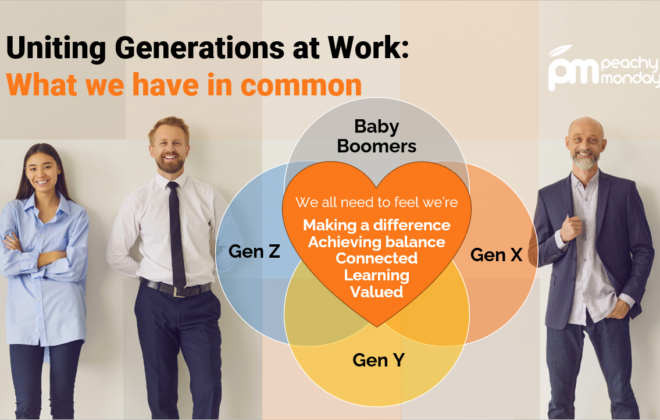The business case for employee engagement
Employee engagement goes above and beyond job satisfaction and employee happiness. It is an emotional state of passion and commitment that brings benefits to employees as well as employers.
Why does employee engagement matter?
Employee engagement is considered by some to be ‘soft and fluffy’ or a ‘pseudoscience’, however there are some compelling reasons for employers to take notice of employee engagement levels and it’s an area where HR professionals can add tangible value.
Business performance
According to Gallup, two thirds of the global workforce (67%) are not engaged at work, putting in time but little discretionary effort¹. In the UK, it is estimated that low employee engagement accounts for a £59.4 – £64.7 billion productivity gap in the UK alone².
Engaged employees will positively promote your products and services to customers, potential customers, family and friends. But whereas 78% of engaged employees would recommend their company’s products and services, it’s only 13% among their disengaged colleagues¹.
Engaged employees are also more innovative and more likely to add value beyond the strict boundaries of their job role: they’re motivated to solve problems and improve their business, even if it “isn’t their job” to do so.
Business investment
Investment analysts are increasingly interested in the employee data behind an organisation’s financial numbers. A hundred years ago, a company’s market capital (the value of a company’s share price multiplied by the number of shares in circulation) was directly related to its tangible assets: property, stock, capital, equipment.
In today’s knowledge economy, the market capital of a company often grossly outweighs the sum of its tangible, book value. The implied intangible assets – predominantly intellectual property and the knowledge, skills and experience of the workforce – can account for as much as 81% of a company’s market capital³. Not surprisingly, there is interest in quantifying the health and value of your greatest asset: your people.
A study of companies undertaken by Towers Perrin-ISR noted a 52% gap in operating income between organisations with the most and least engaged employees4.
Analysts have traditionally used past financial performance as an indicator of future financial performance. In reality, employee engagement levels are actually a far greater predictor of future performance.

Attracting talent
Talent is a key performance differentiator for organisations and competition for the best is fierce. According to a recent survey, 63% of UK organisations are experiencing a skills shortage, with organisations in STEM, health and public sectors experiencing the most difficulty.5
Your potential employees are able to learn a lot about what it’s like to work in your organisation through published employee engagement league tables such as the Sunday Times Best 100 Companies To Work For6.
Social media sites like Glassdoor7 allow employees to anonymously rate their employers and are increasingly powerful candidate decision-making tools. In-demand employees are screening out organisations with poor work environments. Being interviewed by engaged staff who are positive advocates for their business is also more likely to result in offers of employment being accepted.
Retaining talent
Leavers are a big problem for organisations.
- Employees are 75% less productive while they are considering leaving.
- It costs anything from 25 to 100% of salary to replace a leaver.
- It takes around 20 weeks for a knowledge worker to reach 100% productivity in a new role8.
- Disengaged employees are 87% more likely to leave an organisation than their engaged counterparts9.
A little like the old customer adage, keeping an existing employee is much cheaper than finding a new one!
Employee wellbeing
Clearly, it’s preferable from an employee’s perspective to be engaged in their work. We spend an increasing proportion of our time at work. Anyone who has ever done a job they didn’t enjoy, or worked for an employer they didn’t care about (and strongly suspected didn’t care about them) will know that it is not an edifying experience.
Low engagement levels result in higher absence: the average absence rate for an engaged worker is 2.69 days per annum versus 6.19 days for disengaged workers10. Disengaged employees aren’t as motivated to come to work as their engaged counterparts and, in severe cases, the poor work experience itself results in ill health.
A report from 2014 suggests that absence accounts for between 36.3% and 38.6% of an organisation’s salary bill when taking into account both direct costs (salaries) and indirect costs (productivity, opportunity costs, impact on colleagues)11. Improving engagement levels could significantly reduce the cost of absence within your organisation.
If you would like to learn more about how Peachy Mondays can help your business to thrive, get in touch or call us on +44 333 123 9366.
- State of the Global Workforce, Gallup (2017)
- Employee Engagement: How to Build A High Performance Workforce, Gallup (2003)
- Ocean Tomo, LLC (2009)
- The ISR Employee Engagement Report, Towers Perrin-ISR (2006)
- The Open University Business Barometer (2019)
- www.thesundaytimes/best100companies
- www.glassdoor.com
- Engage your people, Future-proof your Company, Human Capital Institute (2014)
- Driving Performance and Retention through Employee Engagement: a quantitative analysis of effective engagement strategies, Corporate Leadership Council, Corporate Executive Board (2004)
- Employee Engagement: How to Build A High Performance Workforce, Gallup (2003)
- The Rising Costs of Employee Absence and How to Manage Them, Kronos (2014)
Related Posts
Categories
- Case Study (13)
- Change and transformation (20)
- Connectedness (4)
- Culture (15)
- Design (10)
- Diversity and Inclusion (1)
- Effectiveness (16)
- Employee engagement (59)
- Employee experience (41)
- Employee Feedback (50)
- Employee Wellbeing (1)
- Events (10)
- Financial Wellbeing (1)
- Happiness (4)
- Internal Communications (9)
- News (24)
- Onboarding (1)
- Organisational Effectiveness (17)
- Uncategorized (3)




